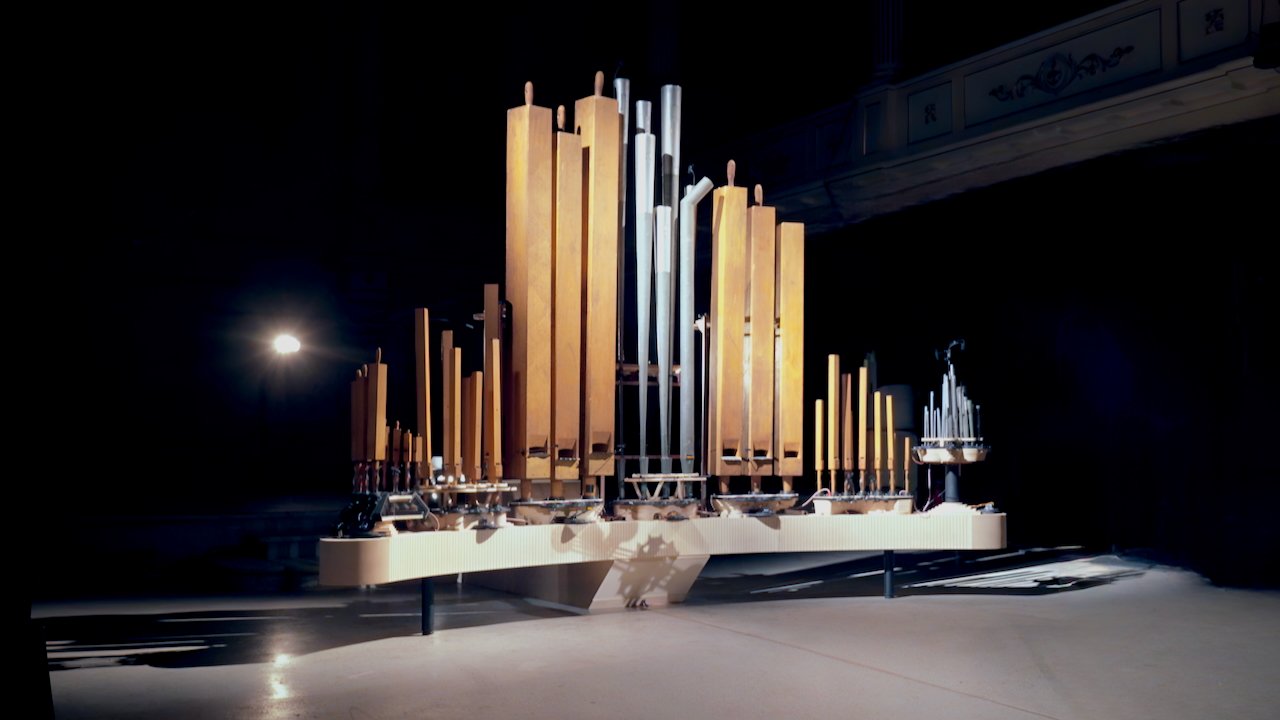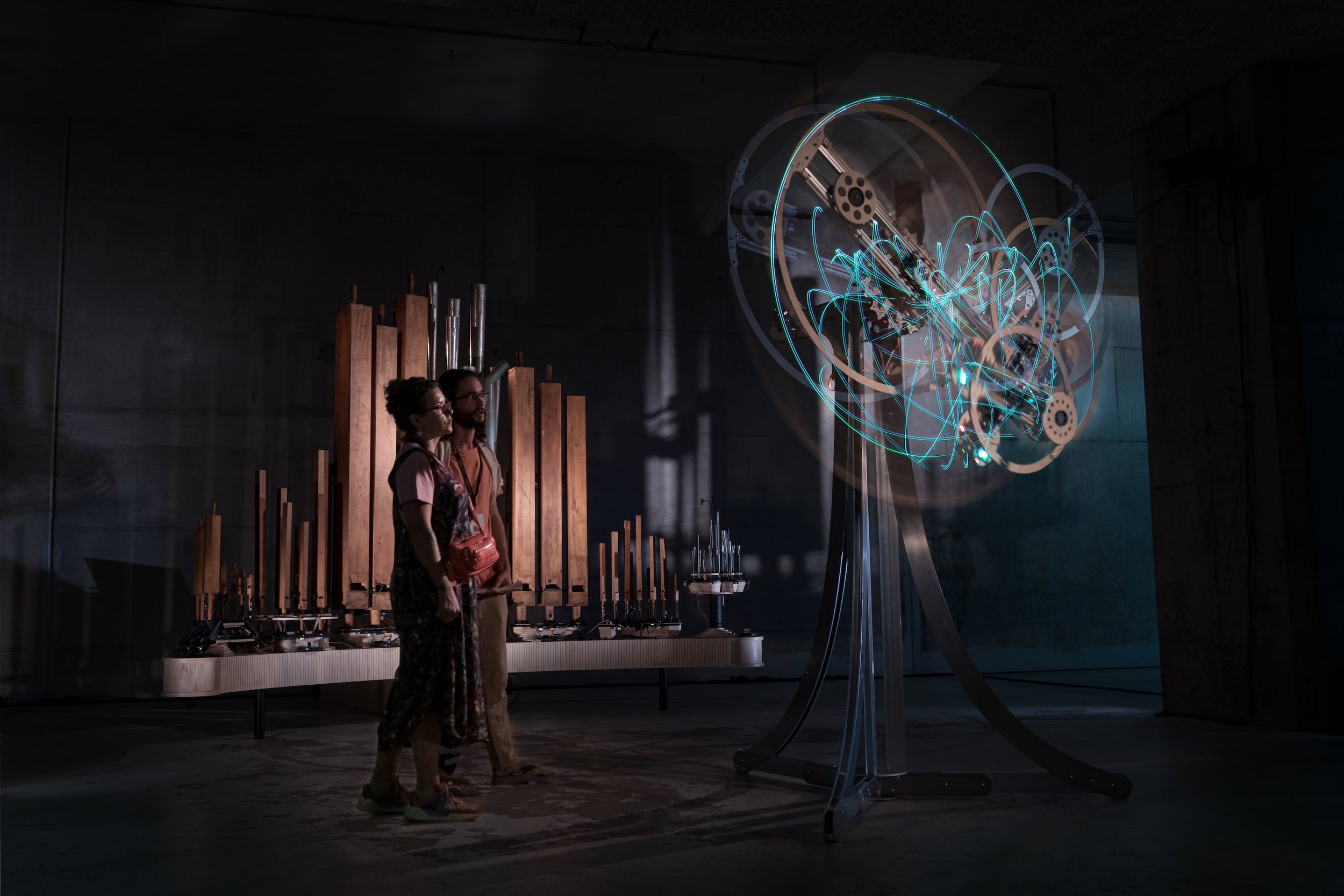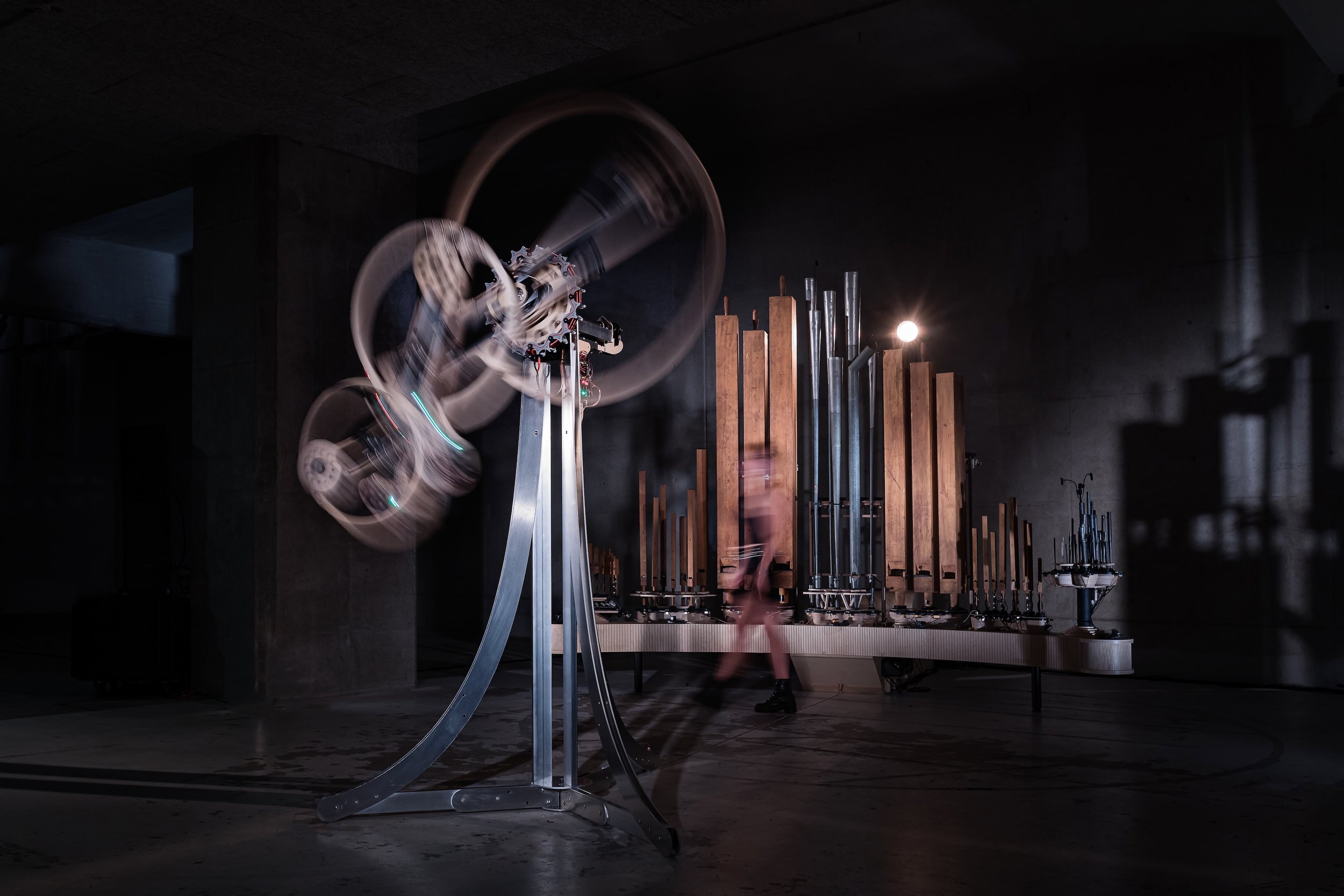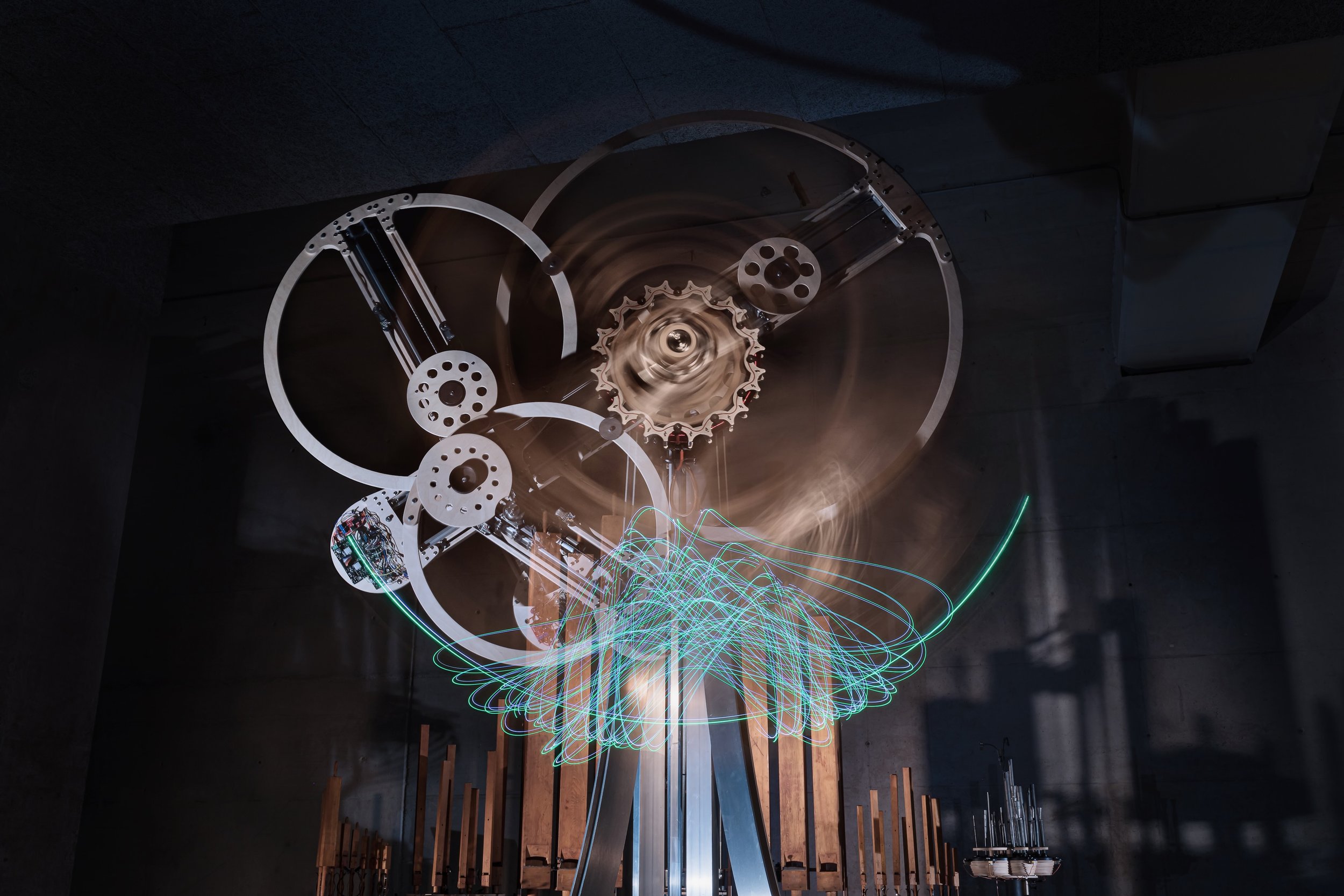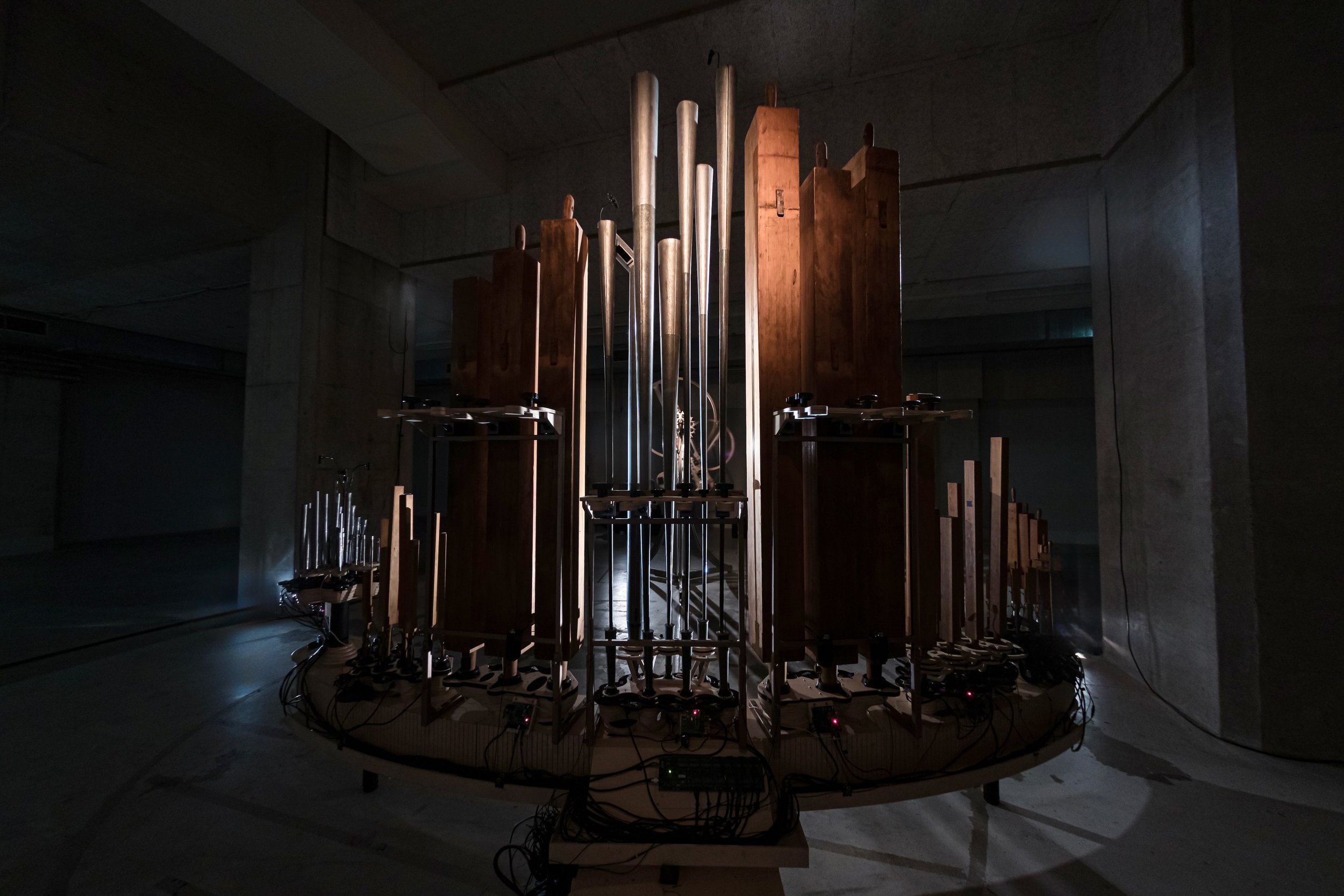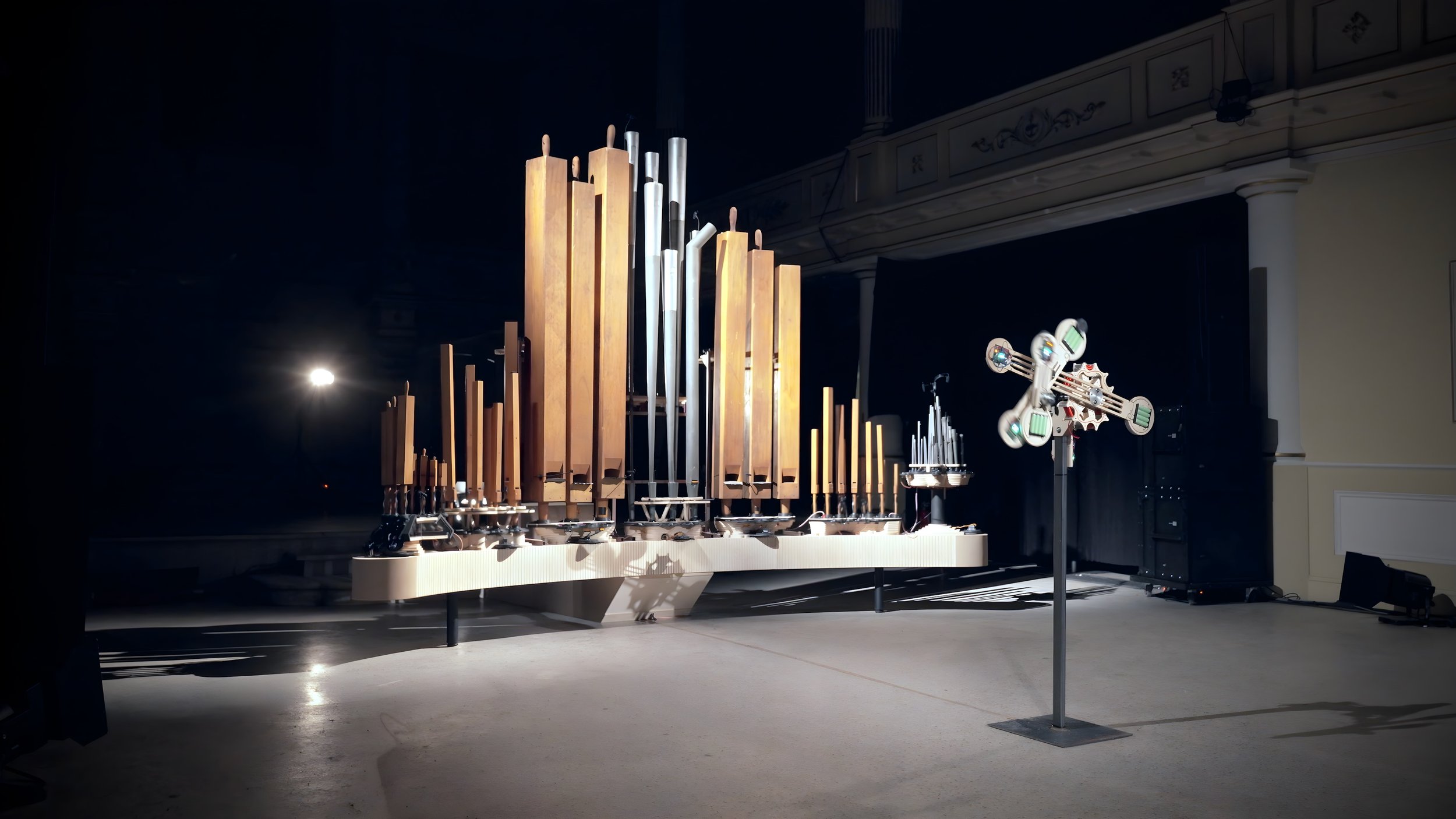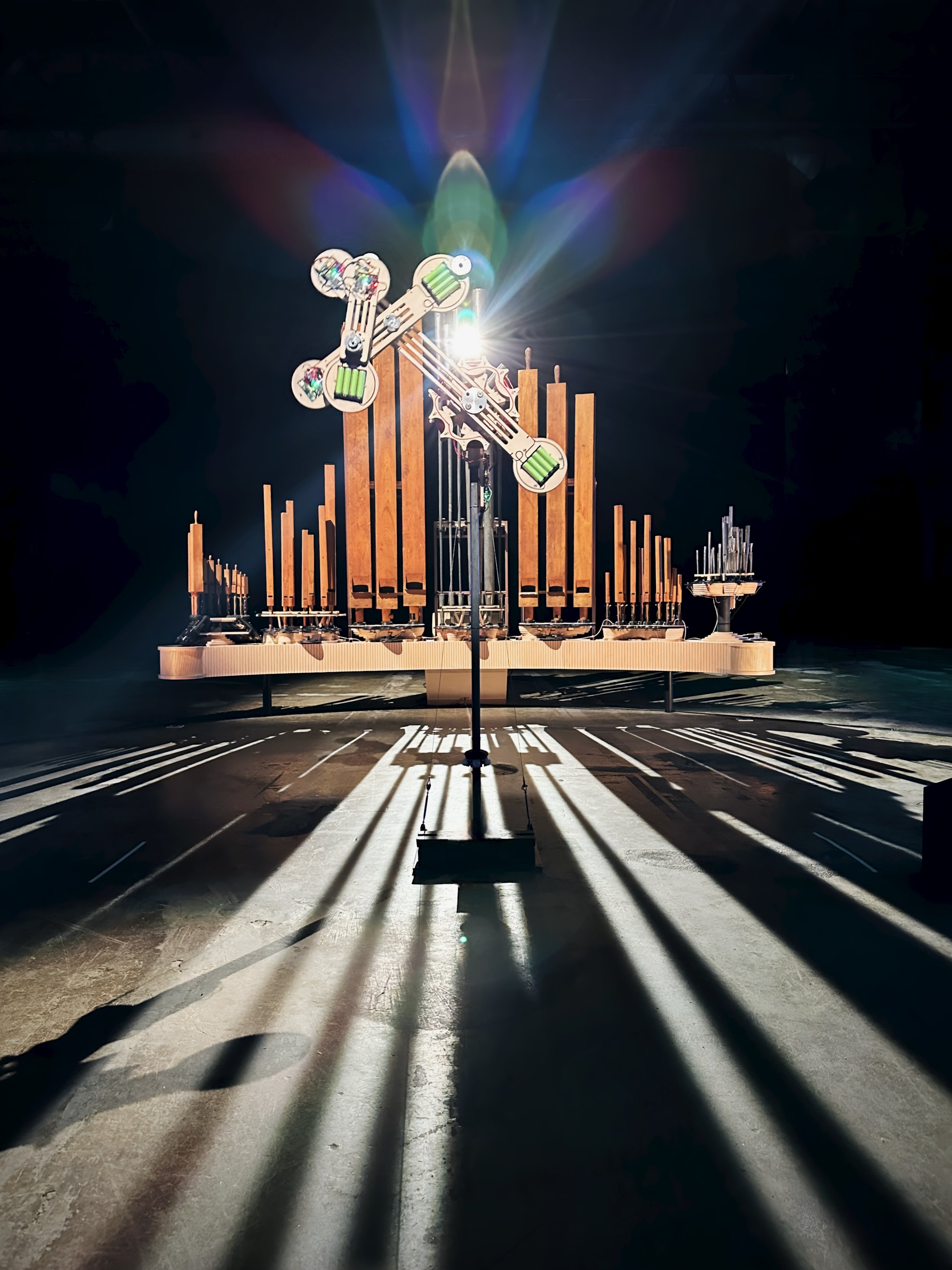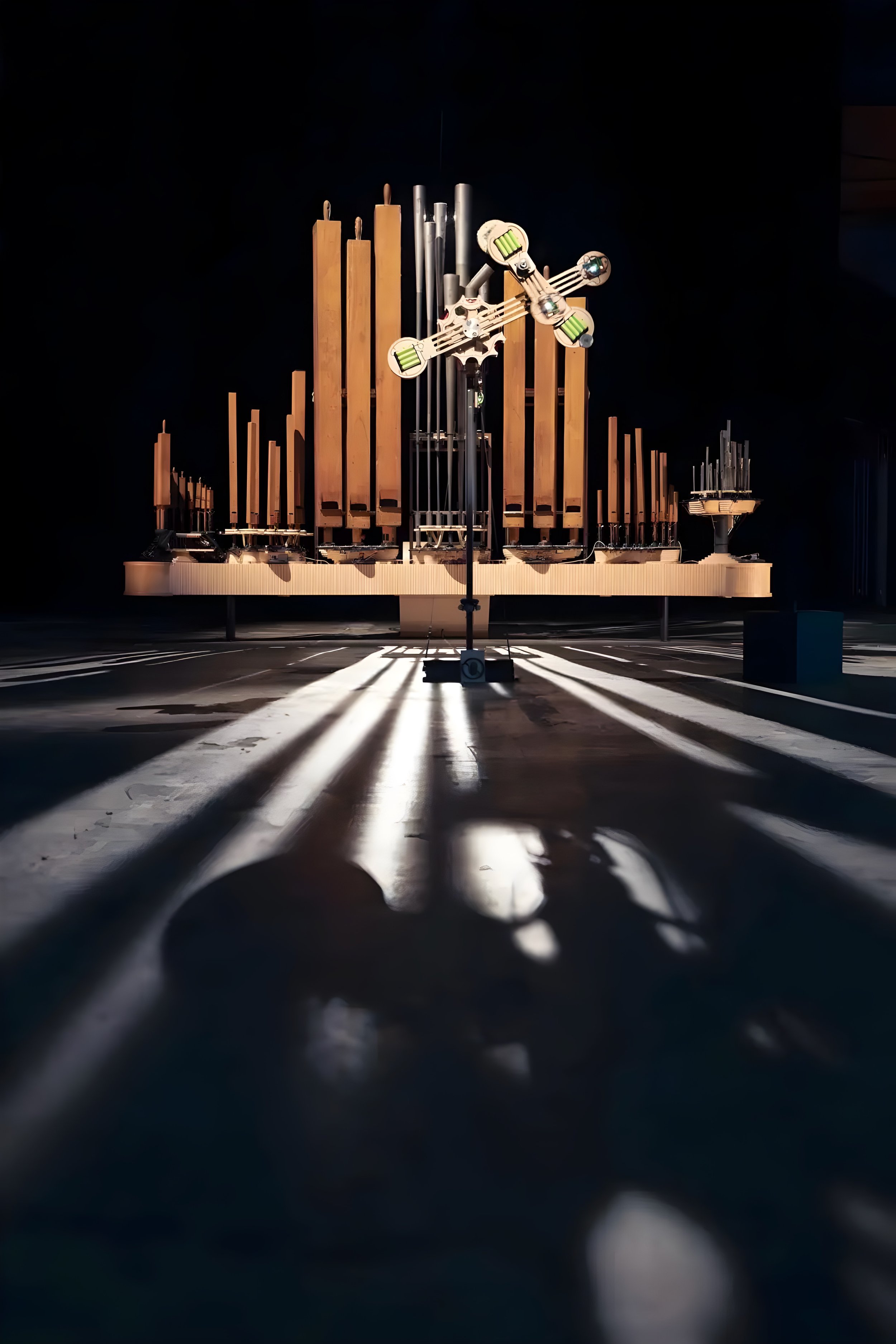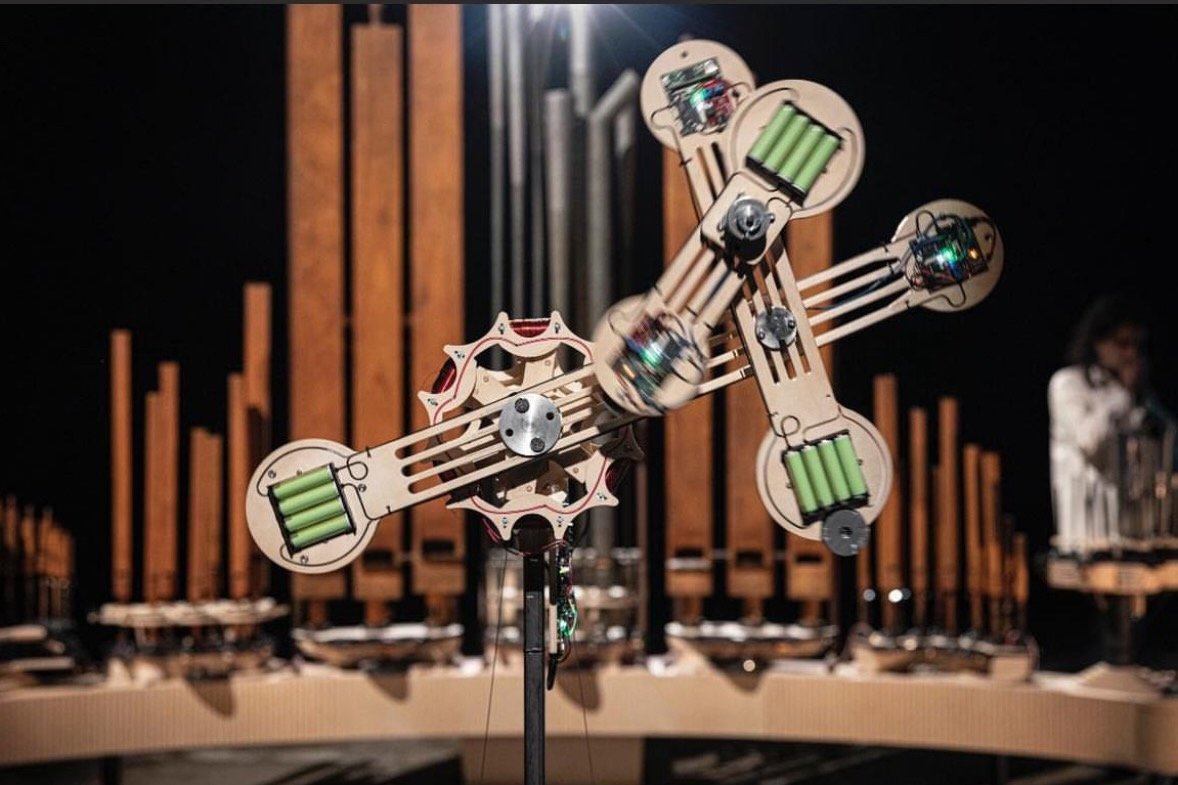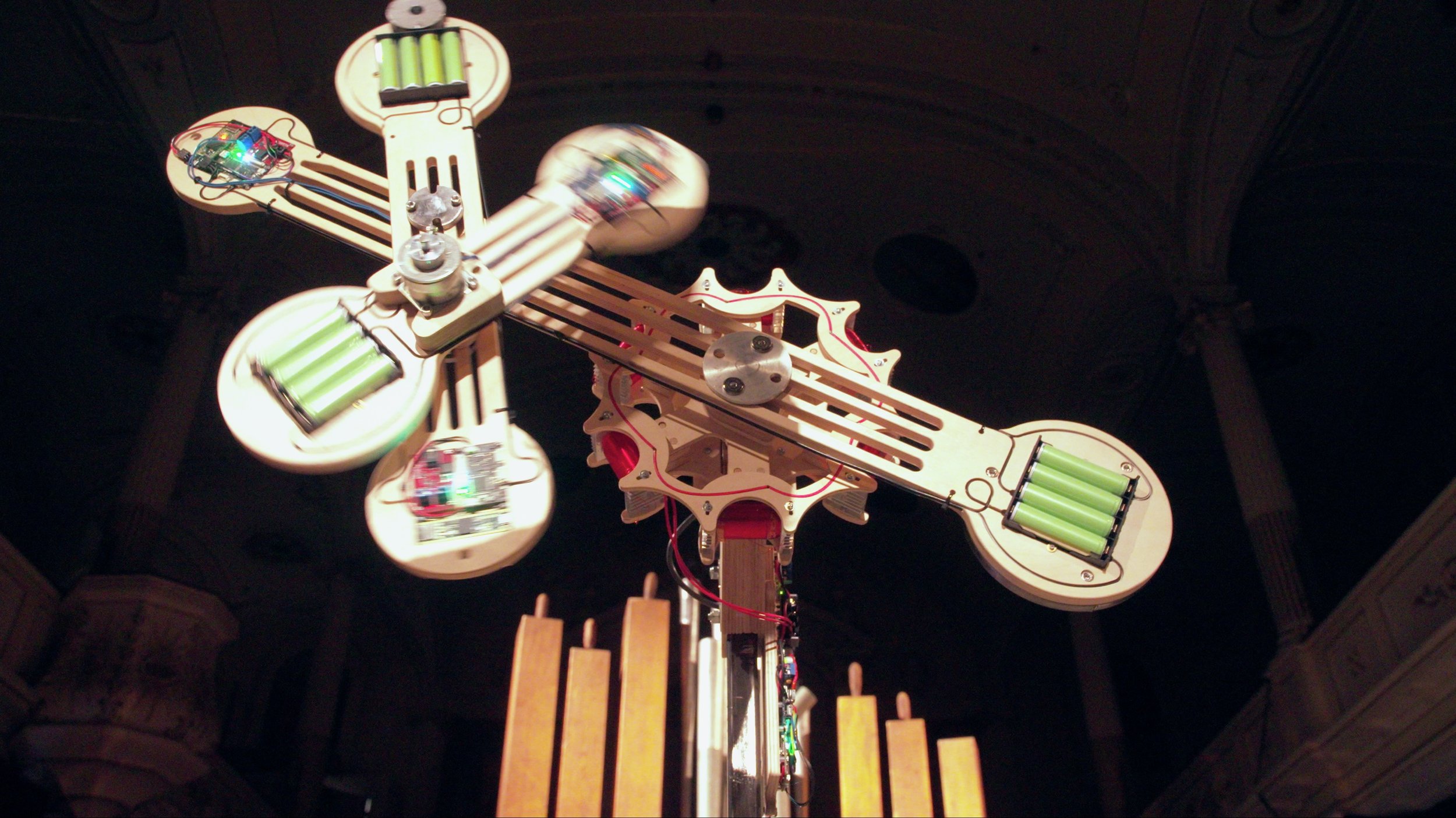Organism + Excitable Chaos
A robotically prepared historic pipe organ driven by a robotically-steered chaotic pendulum
2024, installation, artscience exhibit , kinetic sculpture
The chaotic motion of Excitable Chaos, a robotically‑steered triple pendulum, drives the aerodynamic thresholds of Organism, a robotically‑prepared century‑old pipe organ.
Organism dismantles the socio‑historical tonality of the organ—civilization’s triumph over the turbulence of nature—to liberate and sound its hidden turbulent materiality.
A 1910 Casavant pipe organ, rescued from a heritage site in Montréal, has its pneumatic architecture modified to remove aerodynamic stabilizations that once aimed to eliminate turbulent flow and its uncontrollable sound world, allowing long‑repressed timbres to be heard anew.
Excitable Chaos is a nonlinear movement system animated by the dynamic exchange of potential and kinetic energy across its three interconnected arms. Occasionally, by modulating its pivotal joints and damper weights, it alters the mass‑orbital relationships of its arms, generating distinct movement systems—each a stochastic universe unto itself. Pivotal joints shift the system’s gravitational dynamics, while subtle adjustments to damper weights refine its resonances, phases, and grooves.
These transductive modulations enable the artist to collaborate with chaos—nature’s form‑giving engine—highlighting how even the subtle fluctuations at the smallest of scales are key contributors to the emergence of cohesive behavior, whose next state remains unknowable.
Excitable Chaos’s transductive dance with gravity—its energetic tensions, correlations, and upheavals continuously shaping and unshaping excitable worlds—is sensed and data‑sculpted to reveal its inner liveliness. This multivariate stream of dynamic data, extracted from Excitable Chaos’s generative movement, is mapped onto Organism’s aerodynamic thresholds, conducting its sonic behavior and thus drawing kinetic chaos into dialogue with sonic turbulence. Each undulation opens an indeterminate cycle of cascading oscillations, while chaotic attractors establish self‑similar grooves over time.
The resulting turbulent sonifications of chaos serve as meditations on the spontaneous emergence of more‑than‑oneness in life and nature, and how this wild yet steerable relationality can help us co‑express worlds yet unknown.
Publications. Talks. Reviews. selected
[panel] “Echoes of Entropy,” Rewire, West Den Haag - Alphabetum, 04.2025
[lecture-workshop] “Transductive Resonance,” Hacking Worlds: Artscience Forum + Royal Academy of Art, The Hague, 03.2025
[video-interview] Art Act Days, AAD Talk “미디어 아트는 협업의 예술이다?…Navid Navab,” AAD Talk, 2024.09
[review] Ars Electronica, “A record: More than 112,000 visits to…,” Mario Schmidhumer, 2024.09
[talk] Moment Factory, “Adventures in co-creating with excitable matter”, Montreal, June 2024
[review] Arts and Sciences, “BIAN 2024,” Linda Moussakova, 2024.07
[review] La Press, “le glitch d’art,” Karine Bouchard, 2024.07
[review] art press, “Elektra 7E Biennale Internationale D’Art Numérique,” Dominique Moulon, 2024.07
[essay-profile] Espace Art Actuel, “…Organism + Excitable Chaos,” Pia Baltazar, 2024.07
[review] La Devoir, “quand l’artiste révèle une altérité nouvelle,” Galadriel Avon, 2024.07
[review] Lien Multimedia, “Navid Navab traduit les données scientifiques en oeuvre d'art,” 2024.06
[talk] KIKK Talks, “adventures with excitable matter: from music to surgery,” Namur, Belgium, 2023.09
[panel] MUTEK Forum, “open-source: computation beyond the military-cybernetics complex”, 2023.08
[video-profile], The Link Newspaper, “Organism, The Acoustic, Robotically Prepared Organ,” 2023.03
[panel] Société de musique contemporaine du Québec, “instrument et l’humain en mutation”, 2023.02
Unstable systems are at the heart of contemporary physics, but they were already present as a blind spot in classical physics with the “three-body problem,” that Newton formulated when he realised he was unable to determine the trajectories of more than two celestial bodies undergoing mutual attraction according the laws of gravity. Later Poincaré proved the impossibility of finding a general mathematical solution to this problem. Furthermore, any local solution would require immense computing power, as the system’s behaviour is devoid of any recurring pattern. However, according to Prigogine, this uncertainty is not due to an inherent limit of mathematics, but rather is a fundamental property of nature. The three-armed pendulum entitled Excitable Chaos, added to Organism, is based on this very principle. It acts as a purely analogue, material and hardware-based generative algorithm, enabling the artist to create a kinetic sculpture with infinitely renewed behaviours. By placing acceleration sensors on each moving pendulum arm, Navab can then derive continuously varied streams of data from these movements. These data variations are endowed with both coherence and constant novelty, due to their sensitivity to the slightest differences in the moving system’s initial conditions. Such complex behaviours would be impossible to produce with existing computer techniques. This stream of chaotic variations derived from the pendulum then is transduced and mapped to the various robotics of Organism: to its motors and valves that modulate the flow of air to its organ pipes. In turn, the artwork produces all manners of sonic variation from its turbulent airfow. It is striking to see how, from the same apparatus, the artist manages to create such different aesthetic experiences […] in a kind of hybrid sound-sight-scape where the audience can step back and immerse themselves in the rhythmic correlations between the pendulum’s movements and the musical quasi-patterns that flow from them. Navab plunges us into the experience of sonic and material processes in which the boundaries of mechanical movements, generative algorithms and acoustic materials become blurred and intertwined, to the delight of our ears, eyes and imagination.
Espace Art Actuel, Pia Baltazar, 2024.07
Navid Navab has a surprising relationship with art. The creator first investigated the scientific side of creation thanks to extensive training in sonification, which enables data to be collected and transformed into embodied sound environments. Navab’s approach, marked by multi-sensory experimentation, is rooted in the search for experiences that interweave technological, natural and human elements. At the very heart of his work: chaos.
translated, Lien Multimedia, “Navid Navab traduit …,” 2024.06
… the instrument, whose pipes were taken from an ancestral organ in Montreal, is driven by a chaotic pendulum, whose kinetic motion alone allows it to evolve in form, the monumental object emits desynchronized, cyclical sounds, sometimes harmonious and sometimes mechanized. The artists offer the device the luxury of an interpretation of chaos: technology now has the power to make the reinvented organ blow sounds never produced before.
translated, La Devoir, Galadriel Avon, 2024.07
The laws of physics are an integral part of the installation,[…] the generative movements of a triple pendulum conducts the sound behavior of a robotically prepared century-old pipe organ. The semi-deterministic but unpredictable behavior of the chaotic pendulum was historically used to demonstrate the Theory of Chaos by Henri Poincaré and Mary Cartwright, [revealiing that] tiny differences at each instace can cause totally different paths, making any prediction impossible or difficult in the long term.
translated, Arts and Sciences, “BIAN 2024,” Linda Moussakova, 2024.07
Pictures, version 2, 2024, 09
Pictures, version 1, 2024.02 — 2024-08
Exhibits
version 1 w/ single-state chaotic pendulum
Mois Multi Festival, La Nef, Quebec City, 2024.02 (solo exhibit)
EasternBloc + Ateliers Belleville, Montreal, 2024.03
ELEKTRA Biennale, Arsenal Contemporary, Montreal, 2024.07-08
version 2 w/ roboticized n-state chaotic pendulum








